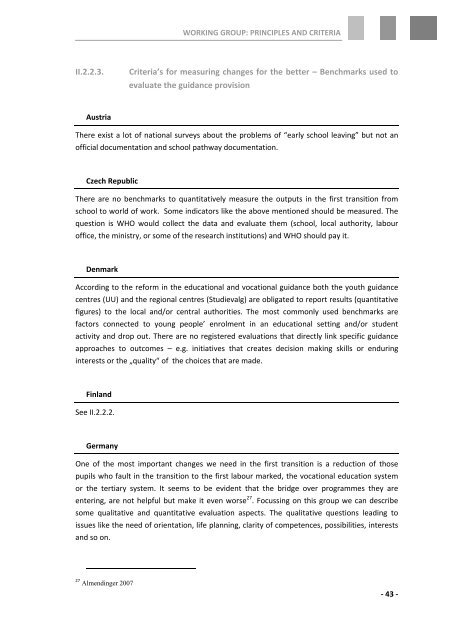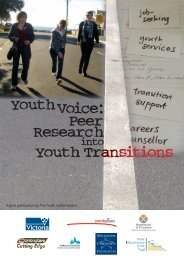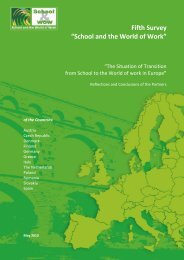Second Survey School and WOW.pdf
Second Survey School and WOW.pdf
Second Survey School and WOW.pdf
Create successful ePaper yourself
Turn your PDF publications into a flip-book with our unique Google optimized e-Paper software.
WORKING GROUP: PRINCIPLES AND CRITERIA<br />
II.2.2.3.<br />
Criteria’s for measuring changes for the better – Benchmarks used to<br />
evaluate the guidance provision<br />
Austria<br />
There exist a lot of national surveys about the problems of “early school leaving” but not an<br />
official documentation <strong>and</strong> school pathway documentation.<br />
Czech Republic<br />
There are no benchmarks to quantitatively measure the outputs in the first transition from<br />
school to world of work. Some indicators like the above mentioned should be measured. The<br />
question is WHO would collect the data <strong>and</strong> evaluate them (school, local authority, labour<br />
office, the ministry, or some of the research institutions) <strong>and</strong> WHO should pay it.<br />
Denmark<br />
According to the reform in the educational <strong>and</strong> vocational guidance both the youth guidance<br />
centres (UU) <strong>and</strong> the regional centres (Studievalg) are obligated to report results (quantitative<br />
figures) to the local <strong>and</strong>/or central authorities. The most commonly used benchmarks are<br />
factors connected to young people’ enrolment in an educational setting <strong>and</strong>/or student<br />
activity <strong>and</strong> drop out. There are no registered evaluations that directly link specific guidance<br />
approaches to outcomes – e.g. initiatives that creates decision making skills or enduring<br />
interests or the „quality“ of the choices that are made.<br />
Finl<strong>and</strong><br />
See II.2.2.2.<br />
Germany<br />
One of the most important changes we need in the first transition is a reduction of those<br />
pupils who fault in the transition to the first labour marked, the vocational education system<br />
or the tertiary system. It seems to be evident that the bridge over programmes they are<br />
entering, are not helpful but make it even worse 27 . Focussing on this group we can describe<br />
some qualitative <strong>and</strong> quantitative evaluation aspects. The qualitative questions leading to<br />
issues like the need of orientation, life planning, clarity of competences, possibilities, interests<br />
<strong>and</strong> so on.<br />
27 Almendinger 2007<br />
‐ 43 ‐




